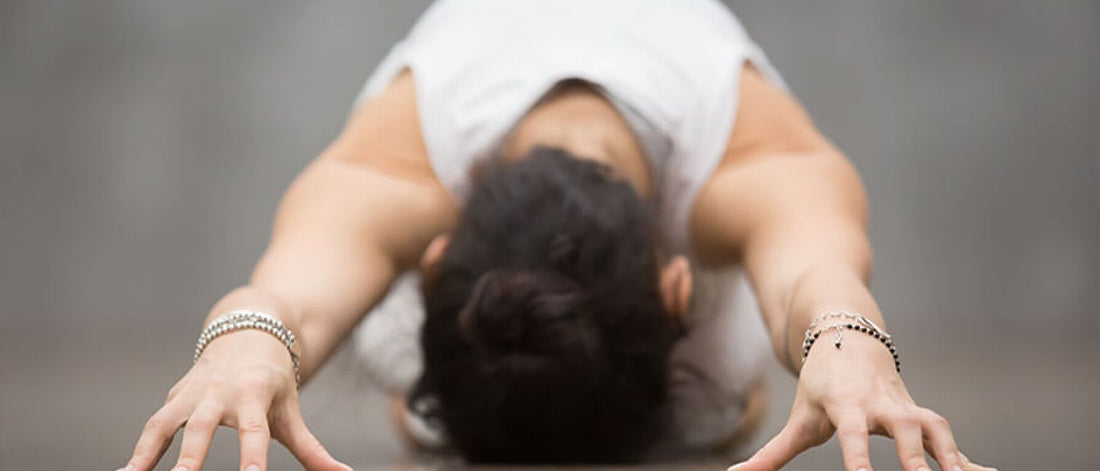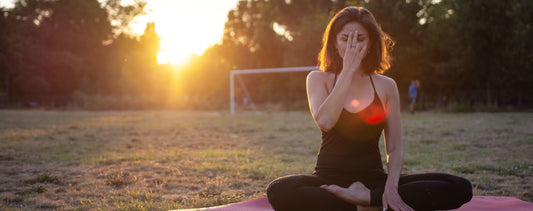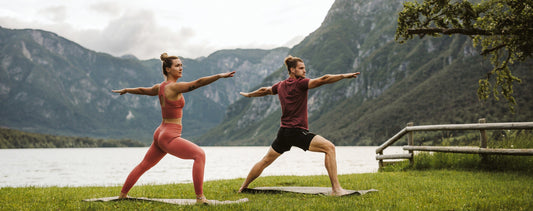There are many reasons why you likely breathe a sigh of relief anytime your teacher tells you to come into Child’s Pose. So much more than just a resting position, Balasana is a chance to slow down, connect to Mother Earth, and recalibrate your entire system.
In an era where stress has become an epidemic, why not gather every tool for not only treating it, but also preventing its grip. It doesn’t get much simpler or accessible than Child’s Pose for calm, comfort, and ease. With plenty of options to modify and expand the sweetly familiar shape, let Balasana be your go-to panacea for whatever ails you.
Your back can seize for any variety of reasons, not to mention acute recurring injury, and this is where Child’s Pose can come to your aid. Child’s Pose stretches and frees up the low back tension, with a delicious downward release into gravity. Depending on how wide apart you place your knees, you can target specific areas of discomfort relatively easily. And the best part is that once you are in the pose, you don’t have to do anything else but breathe deeply.
Because of the way the torso and abdomen rest on (or between) the thighs, Balasana is also an excellent pose for promoting digestion, alleviating gas pain, and relieving menstrual cramps. It can be performed in bed, on the floor, or even laying on your back with your knees pulled in to your chest. The results are the same: the back gets stretched, the hips are opened, the belly receives a comforting compression, and the knees get flexed to promote circulation.
So, if it isn’t the calling of the physical body that invites you into this pose, perhaps it is when you need a moment to reconnect to the moment and slow things down. A quickly approaching deadline? Overactive mind at bedtime? Emotional and weepy? Unexplained stress? Child’s Pose is the calm, reassuring hug you’ve been waiting for.
Balasana is also a chance to go within. It’s quite private in there, when you literally tuck into yourself like a turtle retreating into its shell. Whether you find yourself in a public yoga class or alone in your living room, the security of a well-timed Balasana harkens back to the familiar shape once taken inside the womb—when all was quiet, cozy, and safe. Nothing to see, nowhere else to be, just simply a chance to be with yourself, inside a cocoon of warm serenity. Sounds poetic, but it’s amazing what a few brief moments in this shape can do for the psyche and the spirit.
2-27.jpg Begin by sitting on your shins with your knees a comfortable distance apart, but no more than hip-width to start. Fold forward over your thighs with your toes pointed back and the big toes touching one another. Rest your head on the ground. There are a few ways to do this pose, but the classical form has your arms back by your feet, palms face up. Tuck your chin slightly so you can breathe free and clear through your nose. You can adjust the intensity of the sensations you feel by wiggling the knees closer or farther apart from one another. It is important you be able to relax in the pose, so if you find yourself uncomfortable or struggling to hold the position, try one of the below mentioned modifications.
1-26.jpg To experience more length in the spine and more room around the lungs, widen your knees as wide as you like and reach your arms forward. This is called Utthita Balasana (or, Extended Child’s Pose). A great preparation for Downward-Facing Dog, or an easily accessible rest from it, this version of the pose is somewhat more active, and includes slightly more muscular engagement and awareness. It also creates more space for the belly to hang between the legs, which is comforting in its own way and also allows for different body types to experience the pose with greater ease.
8-12.jpg If you find yourself in a tighter body, or with greater body mass in the belly or chest, placing a block or stack of blankets under your forehead will likely bring you some relief. Since it is vital to the pose that your head be supported, it can be quite helpful to bring the ground closer to you. If you don’t have a block or blanket, simply stack your fists or palms under your head instead.
6-19.jpg Depending on how far along in the pregnancy, most women can access the pose by bringing the knees wide and resting on their forearms instead of the forehead. Placing the forearms on a bolster, pillow, or stack of blankets also allows more room for the belly. In this variation, allow the head to just hang, which will give an added stretch to the back of the neck.
9-11.jpg 3-29.jpg 7-18.jpg
Yet you needn’t wait for the teacher’s invitation. Anytime you feel like you need to catch your breath, rest your body, or reconnect to your center, Balasana is easily accessible. And yet, like the process of blowing up a balloon, Childs Pose can also morph from a completely passive position into one that is vital, vibrant, and full of energy. You can prepare your hands, arms, and back for Downward Dog, establish your Ujjayi Breath for a powerful vinyasa, or more actively stretch your chest and triceps by bending the elbows and taking the thumbs to the nape of the neck.
In short, this calming pose can be anything you want it to be. All it takes is that you give it your full attention and you let it do its job. Let the benefits of Child’s Pose serve you, and it will become your new best friend.
Discover ancient yoga, meditation, and Ayurvedic healing practices to embrace balance and invite flow into every aspect of your life at Seduction of Spirit, our six-day meditation and yoga retreat. Learn More.
In an era where stress has become an epidemic, why not gather every tool for not only treating it, but also preventing its grip. It doesn’t get much simpler or accessible than Child’s Pose for calm, comfort, and ease. With plenty of options to modify and expand the sweetly familiar shape, let Balasana be your go-to panacea for whatever ails you.
Physical Benefits
According to a study out of University of North Carolina, more than 80 percent of Americans will experience low back pain at some time in their lives, making it one of the most common physical ailments in modern society. If you find yourself standing all day long, sitting for extended periods of time, or doing a job that requires heavy lifting or extreme movement (doesn’t this cover just about everyone?), back strain is likely inevitable at some point in your life.Your back can seize for any variety of reasons, not to mention acute recurring injury, and this is where Child’s Pose can come to your aid. Child’s Pose stretches and frees up the low back tension, with a delicious downward release into gravity. Depending on how wide apart you place your knees, you can target specific areas of discomfort relatively easily. And the best part is that once you are in the pose, you don’t have to do anything else but breathe deeply.
Because of the way the torso and abdomen rest on (or between) the thighs, Balasana is also an excellent pose for promoting digestion, alleviating gas pain, and relieving menstrual cramps. It can be performed in bed, on the floor, or even laying on your back with your knees pulled in to your chest. The results are the same: the back gets stretched, the hips are opened, the belly receives a comforting compression, and the knees get flexed to promote circulation.
Mental and Energetic Benefits
But the benefits don’t end there. Balasana is extremely calming to the mind, and activates the parasympathetic nervous system. By placing your forehead on the earth (or a prop), the pose becomes very grounding, which moves your attention from the swirling mind-stuff down into the body and the breath.So, if it isn’t the calling of the physical body that invites you into this pose, perhaps it is when you need a moment to reconnect to the moment and slow things down. A quickly approaching deadline? Overactive mind at bedtime? Emotional and weepy? Unexplained stress? Child’s Pose is the calm, reassuring hug you’ve been waiting for.
Balasana is also a chance to go within. It’s quite private in there, when you literally tuck into yourself like a turtle retreating into its shell. Whether you find yourself in a public yoga class or alone in your living room, the security of a well-timed Balasana harkens back to the familiar shape once taken inside the womb—when all was quiet, cozy, and safe. Nothing to see, nowhere else to be, just simply a chance to be with yourself, inside a cocoon of warm serenity. Sounds poetic, but it’s amazing what a few brief moments in this shape can do for the psyche and the spirit.
Tips for Enjoying Child’s Pose
1. Need more comfort in pose?
2. Head doesn’t reach the floor?
3. Tight knees?
Place a pillow or blanket between the backs of your thighs and your calves. You can also roll up the blanket and put it behind the knees to give your joints even more room. Still not comfortable? Flip the pose on its back. Lie down and hug your knees into your chest with your hands or forearms.3-v1.jpg3-v2.jpg3-v3.jpg3-v4.jpg3-v5.jpg
4. Pregnant?
5. Want even more stretch?
Try this delightful variation to open up the side body even more: Crawl the fingertips over to the right about 12 inches, and let the hips counter to the left. Then switch sides. After returning to center, tent the fingertips and walk them as far forward as you can. Keep the hips grounded and upper arm bones lifted as you breathe deeply into the chest three-dimensionally. If you would like even more chest and shoulder opening, place your hands or forearms on blocks.The Best Time for Child’s Pose
Child’s Pose is the universally accepted resting pose in just about every yoga class. Many teachers skillfully interweave Childs Pose into their sequences as an opportunity to integrate and rest the body after a challenging flow or sequence.Yet you needn’t wait for the teacher’s invitation. Anytime you feel like you need to catch your breath, rest your body, or reconnect to your center, Balasana is easily accessible. And yet, like the process of blowing up a balloon, Childs Pose can also morph from a completely passive position into one that is vital, vibrant, and full of energy. You can prepare your hands, arms, and back for Downward Dog, establish your Ujjayi Breath for a powerful vinyasa, or more actively stretch your chest and triceps by bending the elbows and taking the thumbs to the nape of the neck.
In short, this calming pose can be anything you want it to be. All it takes is that you give it your full attention and you let it do its job. Let the benefits of Child’s Pose serve you, and it will become your new best friend.
Discover ancient yoga, meditation, and Ayurvedic healing practices to embrace balance and invite flow into every aspect of your life at Seduction of Spirit, our six-day meditation and yoga retreat. Learn More.






















